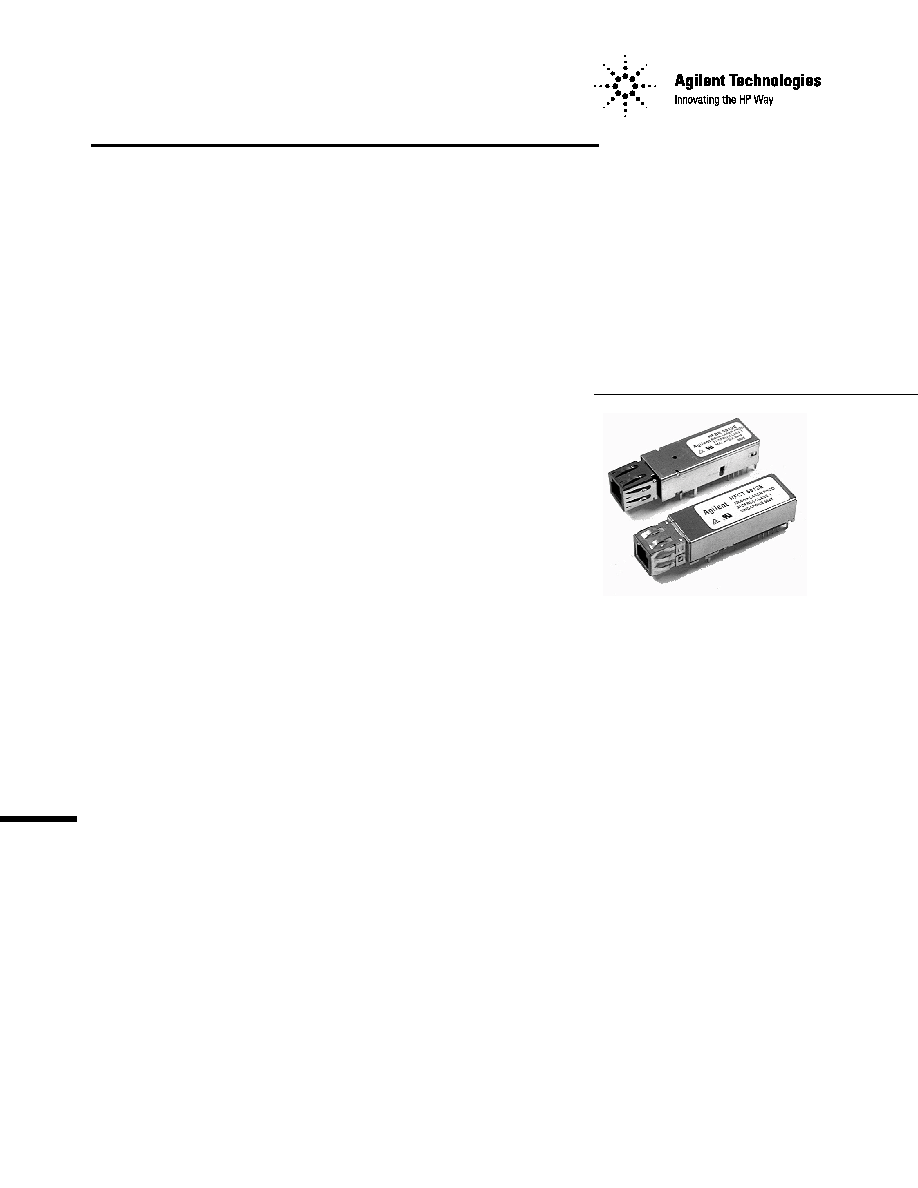Äîêóìåíòàöèÿ è îïèñàíèÿ www.docs.chipfind.ru

Small Form Factor MT-RJ
Fiber Optic Transceivers
for Gigabit Ethernet
Technical Data
HFBR-5912E,
850 nm VCSEL
HFCT-5912E,
1300 nm FP Laser
Features
· Compliant with
Specifications for
IEEE 802.3z/ Gigabit
Ethernet
· Multisourced 2 x 5 Package
Style with Integral MT-RJ
Connector
· Performance
HFBR-5912E (1000 Base-SX)
220 m Links in 62.5/125
µm MMF 160 MHz*km
Cables
275 m Links in 62.5/125
µm MMF 200 MHz*km
Cables
500 m Links in 50/125 µm
MMF 400 MHz*km Cables
550 m Links in 50/125 µm
MMF 500 MHz*km Cables
HFCT-5912E (1000 Base-LX)
550 m Links in 62.5/125
µm MMF Cables
10 km Links in 8/125 µm
SMF Cables
· IEC 60825-1 Class 1/CDRH
Class 1 Laser Eye Safe
· Single +3.3 V Power Supply
Operation with PECL Logic
I/O Interfaces, TTL Signal
Detect and Transmit Disable
· Wave Solder and Aqueous
Wash Process Compatible
Applications
· Switch to Switch Interface
· Switched Backbone
Applications
· High Speed Interface for
File Servers
· High Performance Desktops
Related Products
· Physical Layer ICs Available
for Optical or Copper
Interface (HDMP-1636A/
1646A)
· Quad SERDES IC Available
for High Density Interfaces
(HDMP-1680)
· 1x9 Fiber Optic Transceivers
for Gigabit Ethernet
(HFBR/HFCT-53D5)
· Gigabit Interface Converters
(GBIC) for Gigabit Ethernet
SX HFBR-5601
LX HFCT-5611
Description
The HFBR/HFCT-5912E
transceiver from Agilent allows
the system designer to implement
a range of solutions for multimode
and single mode Gigabit Ethernet
applications.
The transceivers are configured
in the new multisourced industry
standard 2 x 5 dual-in-line package
with an integral MT-RJ fiber
connector.
Transmitter Section
The transmitter section of the
HFBR-5912E consists of an
850 nm Vertical Cavity Surface
Emitting Laser (VCSEL) in an
optical subassembly (OSA),
which mates to the fiber cable.
The HFCT-5912E incorporates a
1300 nm Fabry-Perot (FP) Laser
designed to meet the Gigabit
Ethernet LX specification. The
OSA is driven by a custom silicon
bipolar IC which accepts
differential PECL logic signals
(ECL referenced to a +3.3 V
supply) and provides bias and
modulation control for the laser.
Receiver Section
The receiver of the HFBR-5912E
includes a GaAs PIN photodiode
mounted together with a custom,
silicon bipolar transimpedance
preamplifier IC in an OSA. This
OSA is mated to a custom silicon
bipolar circuit that provides post-
amplification and quantization.
The HFCT-5912E utilizes an InP
PIN photodiode in a similar
configuration.
The post-amplifier also includes
a Signal Detect circuit which
provides a TTL logic-high output
upon detection of an optical signal.

2
APPLICATION SUPPORT
Package and Handling
Instructions
Flammability
The HFBR/HFCT-5912E
transceiver housing consists of
high strength, heat resistant,
chemically resistant, and UL 94 V-0
flame retardant plastic and metal
packaging.
Recommended Solder and
Wash Process
The HFBR/HFCT-5912E is
compatible with industry-
standard wave or hand solder
processes.
Process plug
This transceiver is supplied with
a process plug for protection of
the optical port within the MT-RJ
connector receptacle. This
process plug prevents
contamination during wave
solder and aqueous rinse as well
as during handling, shipping and
storage. It is made of a high-
temperature, molded sealing
material that can withstand
+80°C and a rinse pressure of
110 lbs per square inch. Due to
the differences in the multimode
and single mode connector
construction, the HFBR-5912E
and HFCT-5912E process plugs
are different and not
interchangeable. The multimode
port plug is black and the single
mode variant is a blue color.
Recommended Solder fluxes
Solder fluxes used with the
HFBR/HFCT-5912E should be
water-soluble, organic fluxes.
Recommended solder fluxes
include Lonco 3355-11 from
London Chemical West, Inc. of
Burbank, CA, and 100 Flux from
Alpha-Metals of Jersey City, NJ.
Recommended Cleaning/
Degreasing Chemicals
Alcohols:
methyl, isopropyl,
isobutyl.
Aliphatics:
hexane, heptane
Other:
naphtha.
Do not use
partially halogenated
hydrocarbons such as 1,1.1
trichloroethane, ketones such as
MEK, acetone, chloroform, ethyl
acetate, methylene dichloride,
phenol, methylene chloride, or
N-methylpyrolldone. Also,
Agilent does not recommend the
use of cleaners that use
halogenated hydrocarbons
because of their potential
environmental harm.
Regulatory Compliance
(See the Regulatory Compliance
Table for transceiver performance)
The overall equipment design will
determine the certification level.
The transceiver performance is
offered as a figure of merit to
assist the designer in considering
their use in equipment designs.
Electrostatic Discharge (ESD)
There are two design cases in
which immunity to ESD damage
is important.
The first case is during handling
of the transceiver prior to
mounting it on the circuit board.
It is important to use normal ESD
handling precautions for ESD
sensitive devices. These pre-
cautions include using grounded
wrist straps, work benches, and
floor mats in ESD controlled
areas. The transceiver perform-
ance has been shown to provide
adequate performance in typical
industry production environments.
The second case to consider is
static discharges to the exterior of
the equipment chassis containing
the transceiver parts. To the
extent that the MT-RJ connector
receptacle is exposed to the
outside of the equipment chassis
it may be subject to whatever
system-level ESD test criteria that
the equipment is intended to meet.
The transceiver performance is
more robust than typical industry
equipment requirements of today.
Electromagnetic Interference
(EMI)
Most equipment designs utilizing
these high-speed transceivers
from Agilent will be required to
meet the requirements of FCC in
the United States, CENELEC
EN55022 (CISPR 22) in Europe
and VCCI in Japan. Refer to EMI
section (page 5) for more details.
Immunity
Equipment utilizing these
transceivers will be subject to
radio-frequency electromagnetic
fields in some environments.
These transceivers have good
immunity to such fields due to
their shielded design.
Eye Safety
These laser-based transceivers
are classified as AEL Class I
(U.S. 21 CFR(J) and AEL Class 1
per EN 60825-1 (+A11). They are
eye safe when used within the
data sheet limits per CDRH. They
are also eye safe under normal
operating conditions and under
all reasonably foreseeable single
fault conditions per EN60825-1.
Agilent has tested the transceiver
design for compliance with the
requirements listed below under
normal operating conditions and
under single fault conditions
where applicable. TUV Rheinland
has granted certification to these
transceivers for laser eye safety
and use in EN 60950 and
EN 60825-2 applications. Their
performance enables the
transceivers to be used without
concern for eye safety up to 5.0 V
transmitter V
CC
.

3
CAUTION:
There are no user serviceable parts
nor any maintenance required for
the HFBR/HFCT-5912E. All
adjustments are made at the
factory before shipment to our
customers. Tampering with or
modifying the performance of the
HFBR/HFCT-5912E will result in
voided product warranty. It may
also result in improper operation
of the HFBR/HFCT-5912E
circuitry, and possible overstress
of the laser source. Device
degradation or product failure
may result.
Connection of the HFBR/HFCT-
5912E to a non-approved optical
source, operating above the
recommended absolute maximum
conditions or operating the
HFBR/HFCT-5912E in a manner
inconsistent with its design and
function may result in hazardous
radiation exposure and may be
considered an act of modifying or
manufacturing a laser product.
The person(s) performing such
an act is required by law to
recertify and reidentify the laser
product under the provisions of
U.S. 21 CFR (Subchapter J).
Optical Power Budget
and Link Penalties
The worst-case Optical Power
Budget (OPB) in dB for a fiber-
optic link is determined by the
difference between the minimum
transmitter output optical power
(dBm avg) and the minimum
receiver sensitivity (dBm avg).
This OPB provides the necessary
optical signal range to establish a
working fiber-optic link. The
OPB is allocated for the fiber-
optic cable length and the corre-
sponding link penalties. For
proper link performance, all
penalties that affect the link
performance must be accounted
for within the link optical power
budget. The Gigabit Ethernet
IEEE 802.3z standard identifies,
and has modeled, the
contributions of these OPB
penalties to establish the link
length requirements for 9/125 µm
single mode and 50/125 µm and
62.5/125 µm multimode fiber
usage. Refer to the IEEE 802.3z
standard and its supplemental
documents that develop the
model, empirical results and final
specifications.
Regulatory Compliance
Feature
Test Method
Performance
Electrostatic Discharge
(ESD) to the
Electrical Pins
MIL-STD-883C
Method 3015.4
Class 1 (>1500 V).
Electrostatic Discharge
(ESD) to the MT-RJ
Receptacle
Variation of IEC 801-2
Typically withstand at least 15 kV without damage
when the MT-RJ connector receptacle is contacted
by a Human Body Model probe.
Electromagnetic
Interference (EMI)
FCC Class B
CENELEC EN55022 Class B
(CISPR 22A)
VCCI Class I
Margins are dependent on customer board and
chassis designs.
Immunity
Variation of IEC 801-3
Typically show no measurable effect from a
10 V/m field swept from 27 to 1000 MHz applied to
the transceiver without a chassis enclosure.
Laser Eye Safety
and Equipment Type
Testing
US 21 CFR, Subchapter J
per Paragraphs 1002.10
and 1002.12
EN 60825-1: 1994 +A11
EN 60825-2: 1994
EN 60950: 1992+A1+A2+A3
AEL Class I, FDA/CDRH
HFBR-5912E Accession # 9720151-09
HFCT-5912E Accession # 9521220-20
AEL Class 1, TUV Rheinland of North America
HFBR-5912E: Certificate # E9971083.01
HFCT-5912E: Certificate # 933/510817/05
Protection Class III
Component
Recognition
Underwriters Laboratories and
Canadian Standards Association
Joint Component Recognition
for Information Technology
Equipment Including Electrical
Business Equipment.
UL File # E173874

4
10 km Link Support
As well as complying with the LX
5 km standard, the HFCT-5912E
specification provides additional
margin allowing for a 10 km
Gigabit Ethernet link on single
mode fiber. This is accomplished
by limiting the spectral width and
center wavelength range of the
transmitter while increasing the
output optical power and
improving sensitivity. All other
LX cable plant recommendations
should be followed.
Data Line
Interconnections
Agilent's HFBR/HFCT-5912E
fiber-optic transceiver is designed
to couple to +3.3 V PECL signals.
In order to reduce the number of
passive components required on
the customer's board, Agilent has
included the functionality of the
external transmitter bias resistors
and coupling capacitors within
the fiber optic module. The
transceiver is compatible with a
"dc-coupled" configuration and
Figure 3 depicts the circuit
options. Additionally, there is an
internal, 50 Ohm termination
resistance within the transmitter
input section. The transmitter
driver circuit regulates the output
optical power. The regulated light
output will maintain a constant
output optical power provided
the data pattern is reasonably
balanced in duty factor. If the
data duty factor has long,
continuous state times (low or
high data duty factor), then the
output optical power will
gradually change its average
output optical power level to its
preset value.
Per the multisource agreement,
the HFBR/HFCT-5912E feature a
transmit disable function which is
a single-ended +3.3 V TTL input
signal dc-coupled to pin 8.
As for the receiver section, it is
internally ac-coupled between
the preamplifier and the post-
amplifier stages. The actual Data
and Data-bar outputs of the post-
amplifier are dc-coupled to their
respective output pins (pins 4, 5).
Signal Detect is a single-ended,
+3.3 V TTL output signal that is
dc-coupled to pin 3 of the
module. Signal Detect should not
be ac-coupled externally to the
follow-on circuits because of its
infrequent state changes.
Caution should be taken to
account for the proper intercon-
nection between the supporting
Physical Layer integrated circuits
and this HFBR/HFCT-5912E
transceiver. Figure 3 illustrates a
recommended interface circuit
for interconnecting to a +3.3 V dc
PECL fiber-optic transceiver.
Electrical and
Mechanical Interface
Recommended Circuit
Figure 3 shows the recommended
interface for deploying the Agilent
transceiver in a +3.3 V system.
Also present are power supply
filtering arrangements which
comply with the recommendations
of the small form factor
multisource agreement. This
configuration ensures noise
rejection compatibility between
transceivers from various vendors.
Power Supply Filtering and
Ground Planes
It is important to exercise care in
circuit board layout to achieve
optimum performance from these
transceivers. Figure 3 shows the
recommended power supply filter
circuit for the SFF transceiver. It
is further recommended that a
contiguous ground plane be
provided in the circuit board
directly under the transceiver to
provide a low inductance ground
for signal return current. This
recommendation is in keeping
with good high frequency board
layout practices.
The HFBR/HFCT-5912E is
designed to cope with the
electrically noisy environment
inside the chassis box of Gigabit
data communication systems. To
minimize the impact of
conducted and radiated noise
upon receiver performance the
metal cover at the rear of the
HFBR/HFCT-5912E should be
connected to the host system's
circuit common ground plane.
To maximize the shielding
effectiveness and minimize the
radiated emissions that escape
from the host system's chassis
box the metal shield that covers
the MT-RJ receptacle should
make electrical contact with the
aperture required for the optical
connector. The metal cover at
the rear of the fiber-optic module
is dielectrically isolated from the
metal shield that covers the
MT-RJ receptacle to avoid
conflicts between circuit and
chassis common.
Package footprint and front
panel considerations
The Agilent transceiver complies
with the circuit board "Common
Transceiver Footprint" hole
pattern defined in the original
multisource announcement
which defined the 2 x 5 package
style. This drawing is reproduced
in Figure 5 with the addition of
ANSI Y14.5M compliant
dimensioning to be used as a
guide in the mechanical layout of
your circuit board. Figure 6
shows the front panel dimensions
associated with such a layout.

5
Eye Safety Circuit
For an optical transmitter device
to be eye-safe in the event of a
single fault failure, the transmit-
ter must either maintain eye-safe
operation or be disabled.
In the HFBR-5912E there are
three key elements to the laser
driver safety circuitry: a monitor
diode, a window detector circuit,
and direct control of the laser
bias. The window detection
circuit monitors the average
optical power using the monitor
diode. If a fault occurs such that
the transmitter dc regulation
circuit cannot maintain the
preset bias conditions for the
laser emitter within ± 20%, the
transmitter will automatically be
disabled. Once this has occurred,
an electrical power reset or
toggling the transmit disable will
allow an attempted turn-on of the
transmitter. If fault remains the
transmitter will stay disabled.
The HFCT-5912E utilizes an
optical subassembly consisting of
a short piece of single mode fiber
along with a current limiting
circuit to guarantee eye-safety. It
is intrinsically eye safe and does
not require shut down circuitry.
Signal Detect
The Signal Detect circuit provides
a TTL low output signal when the
optical link is broken or when the
transmitter is OFF as defined by
the Gigabit Ethernet specification
IEEE 802.3z, Table 38.1. The
Signal Detect threshold is set to
transition from a high to low
state between the minimum
receiver input optional power and
-30 dBm avg. input optical power
indicating a definite optical fault
(e.g. unplugged connector for the
receiver or transmitter, broken
fiber, or failed far-end transmitter
or data source). A Signal Detect
indicating a working link is
functional when receiving
encoded 8B/10B characters. The
Signal Detect does not detect
receiver data error or error-rate.
Data errors can be determined by
signal processing offered by
upstream PHY ICs.
Electromagnetic
Interference (EMI)
One of a circuit board designer's
foremost concerns is the control
of electromagnetic emissions
from electronic equipment.
Success in controlling generated
Electromagnetic Interference
(EMI) enables the designer to
pass a governmental agency's
EMI regulatory standard and
more importantly, it reduces the
possibility of interference to
neighboring equipment. Agilent
has designed the HFBR/HFCT-
5912E to provide excellent EMI
performance. The EMI
performance of a chassis is
dependent on physical design and
features which help improve EMI
suppression. Agilent encourages
using standard RF suppression
practices and avoiding poorly
EMI-sealed enclosures.
Radiated Emissions for the
HFBR-5912E and HFCT-5912E
have been tested successfully in
several environments. While this
number is important for system
designers in terms of emissions
levels inside a system, Agilent
recognizes that the performance
of most interest to our customers
is the emissions levels, which
could be expected to radiate to
the outside world from inside a
typical system. In their
application, SFF transceivers are
intended for use inside an
enclosed system, protruding
through the specified panel
opening at the specified
protrusion depth.
Along with the system advantage
of high port density comes the
increase in the number of
apertures. Careful attention must
be paid to the locations of high-
speed clocks or gigabit circuitry
with respect to these apertures.
While experimental measurements
and experiences do not indicate
any specific transceiver emissions
issues, Agilent recognizes that
the transceiver aperture is often a
weak link in system enclosure
integrity and has designed the
modules to minimize emissions
and if necessary, contain the
internal system emissions by
shielding the aperture.
To that end, Agilent's gigabit
MT-RJ transceivers (HFCT-5912E
and HFBR-5912E) have nose
shields which provide a
convenient chassis connection to
the nose of the transceiver. This
nose shield improves system EMI
performance by closing off the
MT-RJ aperture. Localized
shielding is also improved by
tying the four metal housing
package grounding tabs to signal
ground on the PCB. Though not
obvious by inspection, the nose
shield and metal housing are
electrically separated for
customers who do not wish to
directly tie chassis and signal
grounds together. The
recommended transceiver
position, PCB layout and panel
opening for both HFBR-5912E
and HFCT-5912E are the same,
making them mechanically drop-
in compatible. Figure 6 shows
the recommended positioning of
the transceivers with respect to
the PCB and faceplate.
Document Outline




